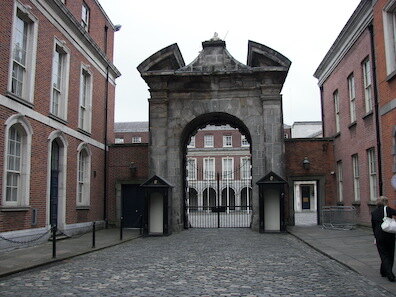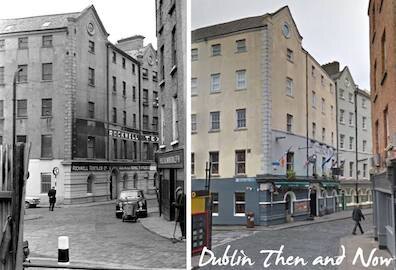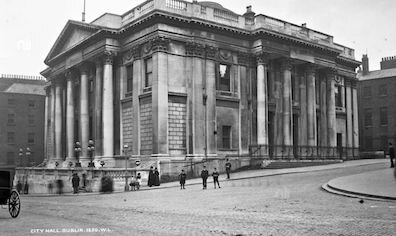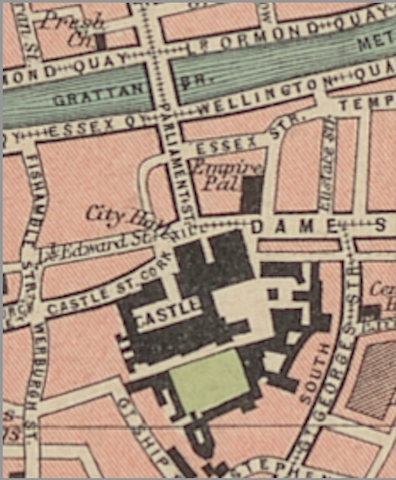Castleyard gate
Castleyard
gate
In Brief
New space-time. Section 15 of Wandering Rocks jumps
across the Liffey once more to spots just a few blocks away
from those seen in section 14. Martin Cunningham, Jack Power,
and John Wyse Nolan leave their place of employment, Dublin
Castle, via "the Castleyard gate" that opens onto its
large northern courtyard and walk riverwards toward "James
Kavanagh's winerooms." A "castle car" is waiting there to pick
them up, but, oddly, it is already near them at the beginning
of the section. Also oddly, at the end of the section the
viceregal cavalcade passes by on Parliament Street, not in an
interpolation from section 19 but in real time and space. One
of the section's two interpolations echoes an action involving
the cavalcade in section 19, but it seems possible that it too
may also be occurring in a more present sense. And a third
seeming interpolation takes place so nearby that it surely is
not one. All of these details have the effect of making
readers question whether they are correctly understanding the
rules of the game.
Read More
Dublin Castle sits about three blocks south of the Liffey, just beyond the intersection where Dame Street turns into Lord Edward Street. At a signal from Martin Cunningham, the driver of a car leaves from the vicinity of the castle's gate and heads "towards Lord Edward Street," but he does not turn left there: nine sentences later the narrative reports that "The castle car wheeled empty into upper Exchange street," a short street that runs north from the eastern end of Lord Edward. Cunningham and the others, meanwhile, walk down "Cork Hill," a section of pavement that goes downhill toward the river, and thence down "Parliament Street," which runs parallel to Upper Exchange one block to the east. Passing "Micky Anderson's watches" (watchmaker Michael Anderson had a shop at 30 Parliament Street), they turn into Essex Street from the east, and the car reaches the same spot from the west: "They followed round the corner towards James Kavanagh's winerooms. The empty castle car fronted them at rest in Essex gate." Kavanagh's was on the corner of Essex and Parliament Street––the spot known as Essex Gate. This final mention of the car, then, suggests that Cunningham has previously arranged for the driver to meet him at a rendezvous point––a fact never mentioned in the novel.
Amid this moderately confusing sequence of events comes an
interpolation: "Bronze by gold, Miss Kennedy's head by Miss
Douce's head, appeared above the crossblind of the Ormond
hotel." The hotel is on Upper Ormond Quay, a couple of
blocks to the northwest, and the interpolation anticipates a
nearly identical sentence in section 19 as the viceregal
cavalcade passes by its windows: "Above the crossblind of the
Ormond hotel, gold by bronze, Miss
Kennedy's head by Miss Douce's head watched and admired."
Clive Hart sees in this linkage the thematic doubling found in
most interpolations: just after Cunningham signals for the
driver of a horse-drawn vehicle to begin moving, readers
become aware of other such vehicles moving east from the
viceregal lodge. But at the end of section 15 Cunningham and
his friends see this procession passing by them in present
time and space. The barmaids were seen looking out their
window onto Ormond Quay only a few minutes earlier, about the
right amount of time for the procession to have crossed the
Grattan Bridge and started moving down on Parliament Street.
Is this really an interpolation, then, or just a slight
spatial jump across the river to an action that is happening
continuously throughout the section?
A similar bit of geographical trickery soon follows. As Cunningham and his companions walk down Cork Hill, narrative attention is directed to a second group of pedestrians: "On the steps of the City hall Councillor Nannetti, descending, hailed Alderman Cowley and Councillor Abraham Lyon ascending." This sounds like an interpolation, since these men do not otherwise figure in section 15 and their number, three, thematically echoes Cunningham's group. But in fact both actions occupy the same space: City Hall is just north of the Castle and Cork Hill goes past its steps. Although the narrative does not say so, the six men may well catch sight of each other and Cunningham may consider asking the councillors for a donation to the Dignam fund––a speculation prompted by the fact that soon afterward he waylays Jimmy Henry walking from City Hall to Kavanagh's and pitches him on the idea. Far more than the glance at Father Conmee in section 2, this small intrusion seems to toy with a reader's expectation of having to perform spatial jumps all the time. Here, no jump at all is required.
About halfway through the section, after Cunningham spots
Jimmy Henry and says "Here goes," a bona fide interpolation
finally arrives: "Outside la Maison Claire Blazes
Boylan waylaid Jack Mooney's brother-in-law, humpy, tight,
making for the liberties." Hart remarks, "Whatever may
be Boylan's reason for waylaying Bob Doran, it is not in order
to raise money for a destitute family" (Critical Essays,
213). The Maison Claire, a dressmaker's shop also seen
in Lestrygonians, was located at 4 Grafton Street. In
section 5 Blazes Boylan shopped in Thornton's fruit and flower shop
at number 63. During the intervening time he has evidently
walked north on Grafton nearly to Trinity College, and now he
spots Bob
Doran on his annual binge of drinking and whoring. Patsy
Dignam will witness their interaction in section
18.
Last but not least of the section's anomalies is the hubbub that closes it. Cunningham's cautious solicitation of Long John Fanning in the Dignam matter is interrupted by a loud clattering of hooves and all the men turn to see "the horses pass Parliament street, harness and glossy pasterns in sunlight shimmering." Once again, interpolation is suggested: the cavalcade's procession along the northern quays, across Grattan Bridge, and through the southeastern quadrant of Dublin will be represented in section 19, and words from that section, "from the shaded door of Kavanagh's winerooms John Wyse Nolan smiled with unseen coldness towards the lord lieutenantgeneral and general governor of Ireland," are echoed here when Wyse Nolan tells Cunningham who it is: "The lord lieutenantgeneral and general governor of Ireland." But as with the men chatting on the steps of City Hall, this is actually happening in present space and time.
The procession must take a considerable amount of time (Clive
Hart figures 46 minutes), and conceptually one can see that
this long stretch must necessarily overlap numerous shorter
scenes represented in earlier sections of the hour-long
chapter. But for readers who know that the cavalcade will be
represented in section 19, its appearance here feels
incongruous. The actions of Wandering Rocks are
supposed to stay in their separate sections, are they not,
connected only by interpolated sentences? Now it appears that
the same action can happen in two sections, and one section
can represent two actions. The possibility that the barmaids
may be watching the cavalcade in the early paragraphs, and the
certainty that Cunningham and his companions are doing so at
the end, seem to imply that section 15 is superimposing the
action of the later section on this one. If so, this maneuver
too comes with thematic linkage: both the viceroy's horsedrawn
journey and Cunningham's are charitable ventures.




